Top Left: View of Puente Nuevo from below. Top Right: Outside the Plaza de Toros de la Real Maestranza de Caballería de Ronda. Bottom Left: View from Ronda toward Parque Natural Sierra de las Nieves. Bottom Right: Alameda del Tajo.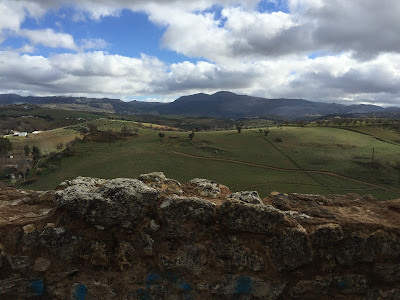

Ronda was the perfect way to pick up where we left off in last year's trip to Andalusia, described in A Tour of Andalusia: Córdoba, Seville and Granada. For the start of this Andalusian tour, we flew into Madrid and took a train to Ronda. We spent 2 and a half days in Ronda, and we felt like we really needed another two days. The weather cooperated with mild temperatures and sunny skies. Ronda was not as crowded as it might get at other times of the year, this being low season. We hired a tour guide, Alfredo Carrasco (www.visitaronda.com, guia@visitaronda.com) and spent a wonderful day walking and talking with him. We highly recommend a tour with Alfredo.
We stayed in an AirBnB accomodation near Plaza Carmen Abela and it was adequate for everything we wanted to see on foot. We took the train to Ronda (from Madrid, one change in Antequera) and from Ronda (to Algeciras for the next leg of our tour).
For an overview of this trip to Andalusia, see A Second Tour of Andalusia: Ronda, Cádiz, and Algeciras.
Flora
Almond - Prunus dulcis [Rosaceae – Rose family] Almond trees were in bloom a few weeks earlier than usual.
Left: Almond trees starting bloom in El Tajo del Ronda. Right: Almond tree blossom.

Chinaberry – Melia azedarach [Meliaceae – Mohagony family] We saw this through our trip to Andalusia and into Portugal.
Left: Chinaberry in front of Iglesia Maria Auxiliadora. Center: Chinaberry near the municipal pool. Right: Chinaberry berries.
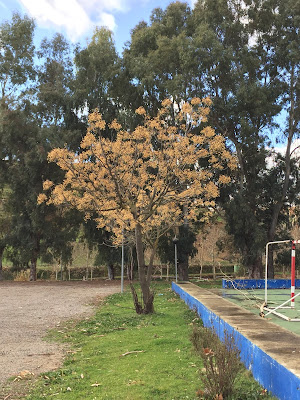

Spanish Fir – Abies pinsapo [Pinaceae – Pine family] This was our first encounter with the stately pinsapo, the national tree of Andalusia.
Three views of pinsapo easily seen around Ronda center showing close-up of leaves and conical crowns. Far right: A door made of pinsapo in the Plaza de Toros de la Real Maestranza de Caballería de Ronda.


Spanish Iris – Iris Xiphium [Iridaceae – Iris family].
An iris blooming in El Tajo Canyon, not far from the Puente Nuevo.![Spanish Irish – Iris Xiphium [Iridaceae – Iris family] Spanish Irish – Iris Xiphium [Iridaceae – Iris family].](https://blogger.googleusercontent.com/img/b/R29vZ2xl/AVvXsEixHyosd6qlrye5J5pIYf67N_5cwexZg84wfOpZkvaHU1B8kLEEDY7E1yrwF6d9lAxqXf8ee2gM3lsnOiF20zpyJnUWfzkInSe18IvGEFTvKqohUNaTuNeNR1MdVha9EH3VZfNfdtwmjw/s400/Spanish+Iris.JPG)
Bulrush [Cyperaceae – Sedge family] Anea is Spanish word for bulrush. We saw a man using it to make small ornamental items using it.
Hackberry tree - Celtis [Canabaceae – Cannabis family] This tree was common around the Arab baths. Nicely branched tree with welcome shade in the summer and a beautiful leaf color in autumn.
Bitter Orange - C. × aurantium [Rutaceae – Citrus family] Street tree in Ronda as elsewhere in southern Spain. A few days later in Algeciras, we saw cleaning crews gathering upthe fruit of the bitter orange trees in Plaza Alta.
Far Left: A man weaves bulrush in Ronda. Center Left: A hackberry trree in Ronda. Center Right: A bitter orange tree in Ronda. Far Right: Maintenance workers collecting oranges in Plaza Alta (Algeciras).
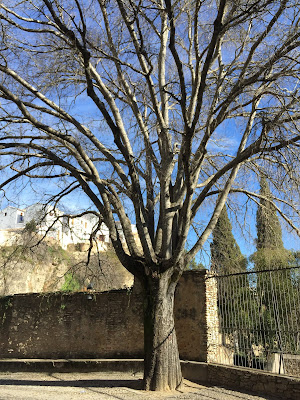

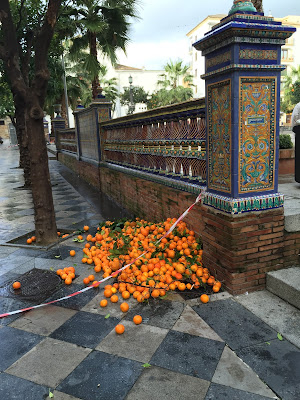
Retama sphaerocarpa [Fabaceae – Pea family] We were given to understand that is plant was used to make a broom we saw being used for street cleaning (photos below). Our guide called it Escopa de palma (“palm broom”). However, escobón (“broom”) seems to be the common name for many plants of the genus Cytisus so there may be some confusion on our part!
Street cleaning brooms in Ronda, Spain. (Isn’t this why people come to Ronda? To take pictures of brooms.)


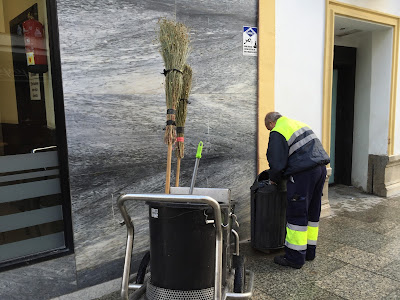
Fauna
A bird we see commonly seen in the gorge is called Cueva del Gato, a Red-billed Chough (Pyrrhocorax pyrrhocorax). They have a beautiful call and mate for life. Our guide Alfredo helped put together the map “The Birds of Malaga” (available on the Serranía de Ronda site). The chough is characteristic of the Serranía de Ronda, where Serranía means “mountain range”.
Sites
Here’s a list of some on the things we saw in Ronda:
- Bridges: Puente Nuevo, Puente Viejo, and the Puente Romano.
The obvious place to start is with the new bridge, but don’t forget to follow the gorge “tajo” east (upstream of the Rio Guadalevin) to find the old bridge and the roman bridge. - Jardines de Cuenca - Cuenca Gardens.
This is a park that has gates at either end, which follows the north edge of the Tajo. The gardens are a series of terraces that take you from the new bridge to the old bridge. - Arab Baths - Baños Arabes - Arab Baths (at their height in the 13th – 15th centuries during the Nasrid rule of Granada, which fell in 1492) Colegiata Santa Maria la Mayor
- Arco de Felipe V
- Plaza Duquesa de Parcent - Duquesa de Parcent Square.
This is a great place to sit and relax under the large trees growing in the square.Nearby is the main cathedral. - Palacio de Mondragón - Mondragon Palace (municipal museum).
- Plaza di Toros, Real Maestranza de Caballería de Ronda.
The bullring visit was more interesting than we expected. Our only other visit to a bullring was in Seville which wasn’t as informative as this visit. Why? Because in the Ronda bullring you learn more about how bulls spend their last night and get guided to the ring for the fight. Also, we got to stand in the center of the ring and test the acoustics. - Palacio del Rey Moro y La Mina - Palace of the Moorish Kingand the Water Mine “La Mina”. The gardens were constructed under the orders of the Duquesa de Parcent, who entrusted their layout to the French designer Forestier. During our visit, the gardens were nice, but not as outstanding as they might be in spring and summer. The real attraction for us was going in the mine and taking the 300+ winding steps down to the Gaudalevin river.
- Plaza de María Auxiliadora
Great views west. Also, the bath to go down beneath the Puente Nuevo can be found at the south end of this plaza. The path can be slippery. And, there’s a point where you can continue under the bridge and walk upstream along waterworks infrastructure, but it’s not for everybody. - Arabic walls and city gates - Murallas de La Cijara (Walls of La Cijara).
Starting near the Arco de Felipe V, you can head south (and up) following the line of the walls. You will end up near battlements and towers in the wall that you can explore. - Mirador de Aldehuela and Balcón del Coño Viewpoints
We totally missed this part of Ronda on our first day because were were concentrated on the area around the Puente Nuevo. Great views west from these viewpoints. Nearby, don’t forget the Alameda del Tajo.
Food
Tragatapas for two lunches and a dinner. Obviously, we really liked it.
Casa de Clemente. Basic, hardy food. +1 on lentil and bread soups.
Las Martirio for dinner – gastro – flamenco - fish restaurant.
Casa Ortega in Plaza del Socorro for dinner. +1 for Casa Ortega’s fried bread crumb / sausage / green pepper dish.
Graffiti
We didn’t find much graffiti, which is a a good thing for Ronda! Two shots and some scribblings on a wall.


Guidance from Above
Left: Altarpiece of the Marian Way of Light in Colegiata Santa María la Mayor. Center: Menu at Casa Clemente with a little heavenly intervention. Right: A procession we saw at Church of Our Lady Round.

Scenes Around Ronda
Left: Puente Nuevo from below. Center: Below the Puente Nuevo. Right: Calle Pedero Romero in Ronda.

Left: Ronda Old Bridge. Right: Night view from Alameda del Tajo.
Left: View from the Palacio del Rey Moro y La Mina. Right: Entrance of the Palace of the Marquis of Salvatierra.

Views of the Plaza de Toros de la Real Maestranza de Caballería de Ronda bullring.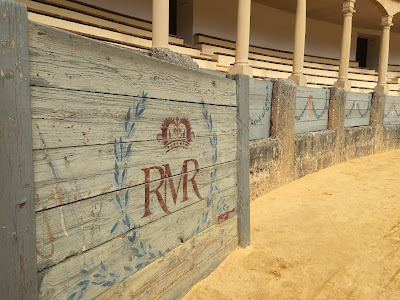

Left: View from Ronda to surrounding countryside. Right: Walking the La Cijara walls.

Brochures
Arab Baths of Ronda
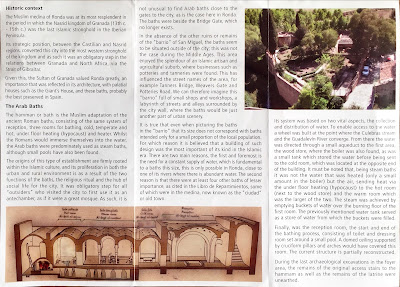
Plaza de Toros de la Real Maestranza de Caballería de Ronda

Colegiata Santa María la Mayor

Forestier’s Hanging Gardens and the Secret Mine.



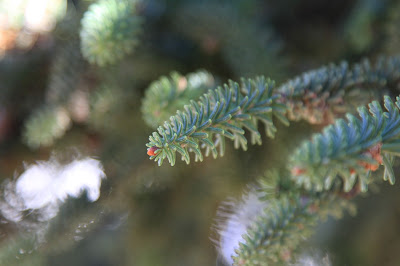






nice
ReplyDelete